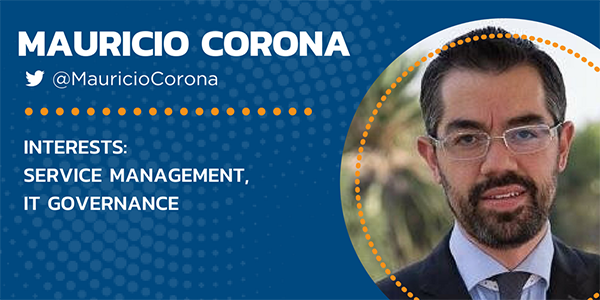Date Published November 14, 2017 - Last Updated December 6, 2017
In January 2017, HDI presented the Top 25 Thought Leaders in Technical Support and Service Management. To help you get to know them better and learn what it means to be a community leader, we’ve interviewed each of our thought leaders. Today, we hear from Mauricio Corona.

Tell us about your day job and also how you are involved in the community.
My day starts early in the morning. After some exercise, the first activity is to prioritize daily activities (including reprioritizing weekly activities). I read international news and think about possible impacts in the market and customers with whom I’m working on several projects in different countries. I read the status of every single project we are running and learn if somebody on my team needs some support from me (I’m always involved in specific tasks in every single project we have).
I participate in international and national IT and standardization boards. I help them develop new standards/frameworks so I can understand the international opinion and challenges that ITSM is facing worldwide. Once I understand and contribute to developing new standards/frameworks, I come back to my region (mainly Latin America) and deliver podcasts and webinars, organize conferences, and bring international speakers to the region so we can create an ITSM community in Latin American countries. Some of the standards/frameworks I have contributed to include the following:
- ITIL
- ITIL Practitioner
- SDI Certification Program
- ISO/IEC 20,000
- NMX-I-20,000
- NMX-I-27,000
- Normative documents from ISO/IEC 38500 family of standards—IT Governance.
- Operational aspects of IT governance including ISO/IEC 30121 standard
- Mexican standards for Information Technology and Telecommunications.
I work closely with international organizations to translate standards, frameworks, and certification exams to the Spanish language.
I have found Facebook, LinkedIn, and Twitter to be the best communication channels to reach the Latin American ITSM community.
What motivates you to be active in the community?
The Latin American community is thirsty for knowledge. This region is constantly growing, and they are always looking to the best way to manage and deliver world-class IT services. In fact, global companies are switching their global operations from several parts of the world to countries like Mexico, Panamá, etc. This is creating a sense of urgency for best practices in the whole region. Unfortunately, the information is not always available in a timely and efficient way to all the people interested. This motivates me every day to try to bring to the region the right information in their own language to contribute to ITSM best practices adoption.
What suggestions do you have for tech support professionals interested in getting more involved in the community?
- Look for international bodies and get involved
- Raise your hand; ask, comment, and share
- Use social media in the right way; always share positive messages
- Create local communities and share
What changes do you anticipate for the nature of IT governance over the next few years?
Companies are still facing old-style management. Company owners created and developed their companies without having a good understanding about how technology enables them even when their companies grew based on tech improvements. Now, 100% of their processes are enabled by technology either directly or indirectly; however, there are some challenges that make it difficult to make this fact understood:
- IT behaves like a “machine repair” department
- IT does not know their role within the company
- IT can’t align with the business because they do not know where the company is going
- Management does not understand how technology services enable their processes
- Board of directors does not understand that they are running a digital business and that IT service management is critical to achieving their goals
Organizations do not have an approach on IT governance. The organizations who do have an approach focus on IT governance rather than identified business governance needs and then align IT governance. Business strategy will certainly lead the way for building real IT governance.
Business strategy will lead the way for building real IT governance.

As the dependency on technology is growing, technological and organizational risks are growing as well. Risk management is or will be one of the key components in order to have the desired control we are expecting in IT governance. Risk management will be at the core of IT governance.
People will need to understand what IT governance is. Those who don’t will fail.
Amy Eisenberg is the editor for HDI where she works with industry experts and practitioners to create content for technical support professionals. She has worked in B2B media and scholarly publishing for more than 20 years, developing content for print and digital magazines, print and email newsletters, websites, conferences, and technical seminars. Follow Amy on Twitter @eisenbergamy, and connect with her on LinkedIn.